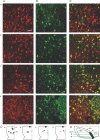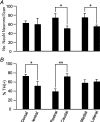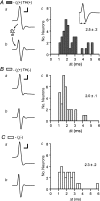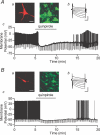The ventral tegmental area revisited: is there an electrophysiological marker for dopaminergic neurons?
- PMID: 16959856
- PMCID: PMC1890372
- DOI: 10.1113/jphysiol.2006.117069
The ventral tegmental area revisited: is there an electrophysiological marker for dopaminergic neurons?
Abstract
The ventral tegmental area (VTA) and in particular VTA dopamine (DA) neurons are postulated to play a central role in reward, motivation and drug addiction. However, most evidence implicating VTA DA neurons in these functions is based on indirect electrophysiological characterization, rather than cytochemical identification. These physiological criteria were first established in the substantia nigra pars compacta (SNc), but their validity in the VTA is uncertain. In the current study we found that while 88 +/- 2% of SNc neurons labelled by the neuronal marker NeuN were co-labelled for the catecholamine enzyme tyrosine hydroxylase (TH), a much smaller percentage (55 +/- 2%) of VTA neurons co-expressed TH. In addition, using in vitro whole-cell recordings we found that widely accepted physiological criteria for VTA DA neurons, including the hyperpolarization-activated inwardly rectifying non-specific cation current (I(h)), spike duration, and inhibition by DA D2 receptor agonists, do not reliably predict the DA content of VTA neurons. We could not distinguish DA neurons from other VTA neurons by size, shape, input resistance, I(h) size, or spontaneous firing rate. Although the absence of an I(h) reliably predicted that a VTA neuron was non-dopaminergic, and I(h)(-) neurons differ from I(h)(+) neurons in firing rate, interspike interval (ISI) standard deviation, and ISI skew, no physiological property examined here is both sensitive and selective for DA neurons in the VTA. We conclude that reliable physiological criteria for VTA DA neuron identification have yet to be determined, and that the criteria currently being used are unreliable.
Figures










References
-
- Aghajanian GK, Bunney BS. Central dopaminergic neurons – neurophysiological identification and responses to drugs. Life Sci. 1973;13:643–648.
-
- Cameron DL, Wessendorf MW, Williams JT. A subset of ventral tegmental area neurons is inhibited by dopamine, 5-hydroxytryptamine and opioids. Neuroscience. 1997;77:155–166. - PubMed
-
- Carr DB, Sesack SR. GABA-containing neurons in the rat ventral tegmental area project to the prefrontal cortex. Synapse. 2000a;38:114–123. - PubMed
-
- Chudasama Y, Robbins TW. Psychopharmacological approaches to modulating attention in the five-choice serial reaction time task: implications for schizophrenia. Psychopharmacology (Berl) 2004;174:86–98. - PubMed
Publication types
MeSH terms
Substances
Grants and funding
LinkOut - more resources
Full Text Sources
Miscellaneous

